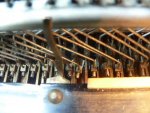M
maugein96
Guest
OK, you go to your first lesson and your tutor tells you that it's up to you how many shoulder straps you use. You are shown that you can get by with only the right strap, with the base of the accordion resting on your knees. It is explained by using this method you have greater control of the bass side and are not restricted in your left arm movement by a left shoulder strap.
You are also shown that you don't actually need any shoulder straps at all if you support the accordion entirely on your knees.
Your second hand accordion already has two shoulder straps which you had to pay extra to have fitted, so what do you do?
Very few teachers will teach you to play standing, so why did you pay extra for the shoulder straps when you bought the accordion?
For a small to medium accordion, provided you only play seated, the right shoulder strap will suffice. I've tried it and it does free your left arm to give more control of the bass side. It probably would not be suitable for the big 5 voice jobs and the free bass players, but then I don't know anything about such instruments.
Looking forward to hearing your views on this!
You are also shown that you don't actually need any shoulder straps at all if you support the accordion entirely on your knees.
Your second hand accordion already has two shoulder straps which you had to pay extra to have fitted, so what do you do?
Very few teachers will teach you to play standing, so why did you pay extra for the shoulder straps when you bought the accordion?
For a small to medium accordion, provided you only play seated, the right shoulder strap will suffice. I've tried it and it does free your left arm to give more control of the bass side. It probably would not be suitable for the big 5 voice jobs and the free bass players, but then I don't know anything about such instruments.
Looking forward to hearing your views on this!





